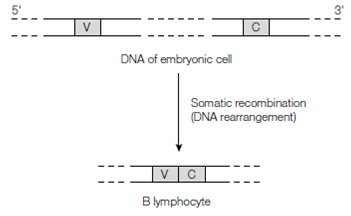Recombination of light chain genes
The variable V region of a light chain is encoded through a separate DNA sequence from which encoding the constant C region. These two segments lie on the similar chromosome but they are sited some way apart. In duration maturation of the B lymphocyte the C and V region DNAs are moved next to every other and are joined together to established a functioning light chain gene. This somatic recombination commonly occurs through deletion of the DNA among the germ-line V and C regions but can also occur in some cases through an inversion mechanism.

Figure: In the germ-line (embryo) DNA, sequences coding for the variable (V) region lie distant from those encoding the constant (C) region. During the differentiation of B lymphocytes, these two sequences are brought together to form an active antibody gene by deletion of the intervening DNA (somatic recombination).
In fact, the condition is rather more complex than this simple model defines. The germ-line V gene segment that is shown in the figure encodes only about the first 97 amino acids of the variable region of the light chain polypeptide. The residual few amino acids of the light chain variable region (residues 98–110) are encoded through a piece of the DNA known as the J gene segment. This J segment must not be confused with the J chain in IgM pentamer. In germ-line the J gene segment lies just upstream of the C gene segment and divided from it only through an intron. In addition, there are multiple J and V gene segments; in humans about 40 V and 5 J regions exist.
In during of B-lymphocyte differentiation, one of the 40 or so V regions becomes connected precisely to one of the J gene segments to establish a light chain gene. This somatic recombination procedure is known as VJ joining. In Figure, V3 has been chosen for recombination and has connected to J2. The Transcription now begin just upstream of the recombined V segment just upstream of V3 and continues until the end of the C segment. The another J segment series are also transcribed, but these series are lost during subsequent RNA splicing which erased the intron upstream of the C segment. Therefore the final mRNA holds only V3J2C sequences and encodes a corresponding light chain polypeptide. Whole, about 200 several human κ light chains can be made through joining any one of the 40 V segments to any one of the J gene segments.
The λ light chain genes also arise through somatic recombination throughout maturation of the B lymphocyte but there are fewer J and V gene segments than for κ chain genes. Many antibody molecules have not λ light chains and κ light chains.